Now that you are getting ready to start using Finasteride, you will notice that many people have worried about its side effects.
As Finasteride is one of the most potent and standard tools we have today for treating hair loss or benign prostate enlargement, its easy access allows every patient to experience and say something completely different from one another.
However, the main issue is mostly the same: Patients are mainly worried about the side effects of Finasteride on a patient’s libido and sexual life.
And yes, Finasteride has specific side effects, regardless of how rare and easily reversible they are, so it is helpful to know what they are and their rareness before making a decision.
TL;DR
➡ Finasteride is an oral medication used for reversing hair loss that works by inhibiting the production of male pattern baldness hormone called dihydrotestosterone (DHT).
➡ As Finasteride is an oral medication, it has a chance of creating certain rare side effects. However, just like its effectiveness, its side effects depend on continuous use.
➡ Various studies over the years show that all side effects of Finasteride fade away when you stop using the medication, leave no permanent effect, and are extremely rare.
➡ The ideal way to benefit from the medication is by knowing that you can quickly stop using it when a side effect occurs and advising your doctor on your medical history so that another condition does not trigger these effects.
In this article, I will go through all the common sexual side effects of Finasteride while distinguishing truth from myth and explain what you can do to help you minimize your risks and decide on whether to use it:
Table of Contents
Let’s first understand what exactly Finasteride is and what it does:
What Is Finasteride?
Finasteride is the popular medication we have in the medical field of dermatology for treating, slowing, and even entirely stopping hair loss. Finasteride owes this fame to its effectiveness as one of the most vital medications for preventing hair loss and supporting hair transplantations by increasing hair thickness. That is why it is an FDA-approved supplement medication and usually appears as a 1 mg oral dosage pill.
Common Finasteride Brand Names
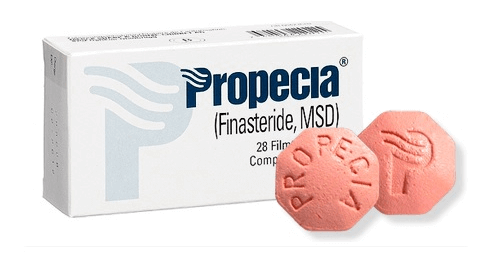
Propecia
Finasteride usually appears under its most common brand name, Propecia. It is the brand name of the drug that contains it, and it is one of the most popular versions of the medication. This version of Finasteride is in smaller doses of 1 mg and is used for preventing hair loss.
Proscar
Finasteride can also appear under the brand name Proscar as an actual example. However, although Proscar contains Finasteride, its dosage is much higher than Propecia (5 mg compared to 1 mg), which is why Proscar is mainly used to treat benign prostatic hyperplasia (BPH) patients.
How Does Finasteride Work?
Finasteride’s primary way of work is inhibiting/preventing the hormones that cause balding in men (which we call male pattern baldness (MPB) due to the same hormone creating the same results) in a repeating pattern.
Usually, without an inhibitor like Finasteride, your hairs start to fall mainly because your body constantly and excessively produces these hormones that build up to a harmful amount. As they build up with every day, your hair starts to fall at a pace that gets dangerously faster in time, which then turns into MPB.
The primary hormone causing MPB is called dihydrotestosterone (DHT). An enzyme that converts testosterone to DHT produces this hormone in your body. That enzyme is called 5 alpha-reductase, or 5-α reductase for short.
When we put Finasteride into this scenario, it starts preventing this enzyme from working. Thus, testosterone no longer converts to DHT. As Finasteride works by preventing or, in other words, by inhibiting the 5-α reductase enzymes to, in turn, stop the DHT hormone that causes baldness, it is called a synthetic 5-α reductase inhibitor.
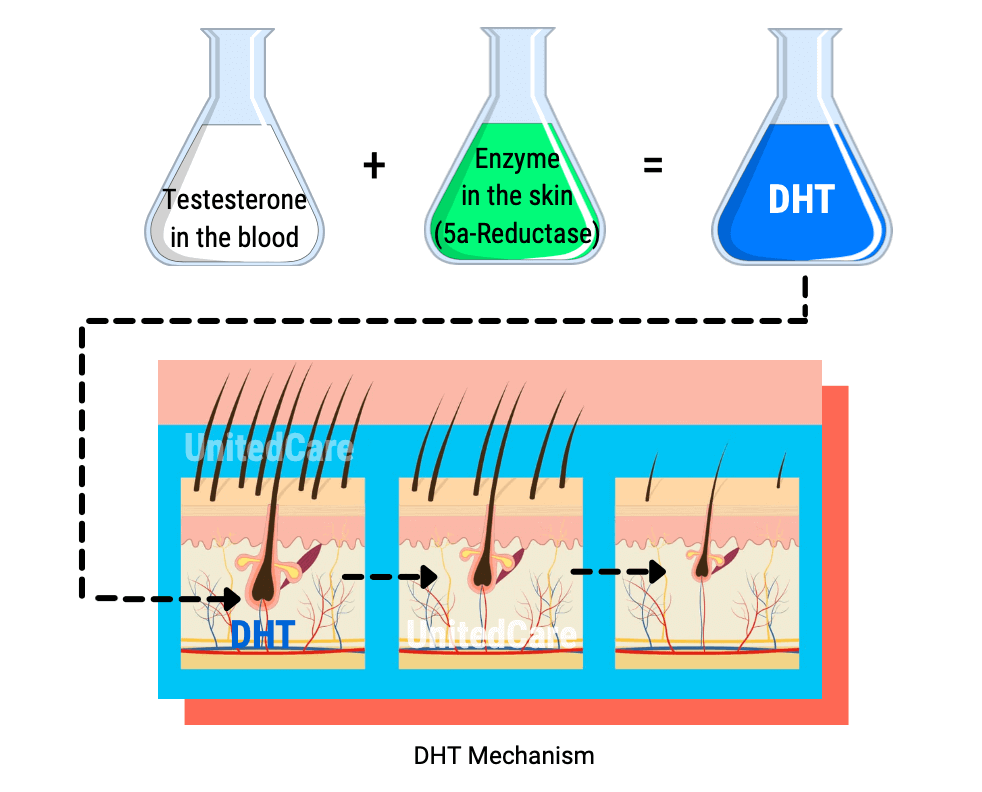
Overall, Finasteride shows its effectiveness by directly locating and preventing the hormones that cause baldness.
When you take the 1 mg dose of oral Finasteride daily, each day you consume the medication, Finasteride prevents the hormone DHT from being produced until the next morning. With every day that passes, your hairs continue avoiding the DHT hormone. And since no factors are causing your hair to regress, it continues to grow at its normal state.
Furthermore, if you have any parts in your head that were on the brink of becoming completely bald, Finasteride does the favor of returning these parts to their past, natural selves. As DHT no longer causes baldness to progress in these parts, your hairs in these areas get a chance to regain their health and fill out the empty spaces by regrowing completely.
However, since its process includes interacting with the primary male sex hormone, testosterone, there are speculations and questions from patients regarding its sexual side effects.
No need to worry. I am here to clear out these exact questions from your mind:
Sexual Side Effects of Finasteride
When we are talking about the sexual side effects of Finasteride, there are two points that we must carefully clear out:
1️⃣ Which one is a myth, and which one is a natural side effect?
2️⃣ Are they caused by another disorder that was present or the nocebo effect?
Each of these questions is a matter of controversy, so let’s focus on clearing them out through various studies:
1- Decreased Sex Drive (Sexual Dysfunction)
This is the most commonly spoken side effect of Finasteride, and although it is rare, it is not a myth but totally a real possibility.
Looking at the history of Finasteride, we can see that the first studies about its side effects mainly focused on whether it affects the sex drives of patients. However, a study from 2017 has brought new evidence that changed our perception of why and how all the sexual side effects of Finasteride occur.
🔹 In the 2017 study, 4284 men aged 16 to 42 years were selected randomly as candidates for research. These patients took a daily dose of approximately 1 mg of Finasteride. They were also observed four years after the initial tests to test whether any existing sexual side effects persisted.
And out of the study, researchers have found two crucial outcomes:
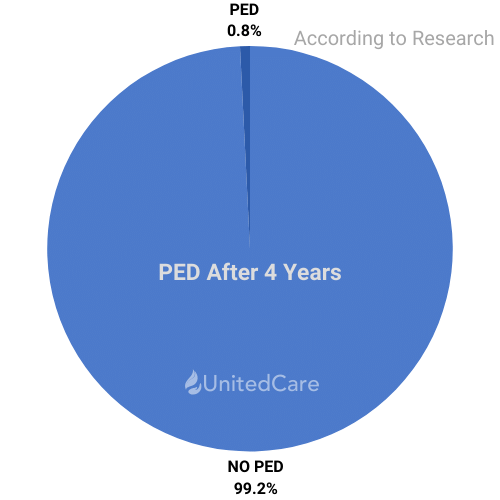
1️⃣ Out of 4284 patients who have never experienced a sexual dysfunction before, only 34 (0.79%) reported that they experienced persistent sexual dysfunction after they stopped using Finasteride for four years.

2️⃣ Additionally, out of 103 young men who had a sexual dysfunction, only 34 (33%) reported that it became persistent.
Based on this information and future observation, the group of doctors and researchers conducting this study realized that another factor was highly affecting the appearance rate of decreased sex drive and all other potential side effects: The nocebo effect (or the placebo effect, but occurring negatively). 👈
⚠️ To best summarize the nocebo effect, we can say that it is a negative effect that high stress leaves on your body. In other words, research shows that patients misinformed or scared about a medication’s dangers and side effects are statistically more likely to experience these effects.
Although this study shows us that decreased sex drive, like every other side effect, is mostly caused by nocebo, ultimately, it mostly centers around erectile dysfunction as it is easier to record. So, let’s look at a study that also focuses on sex drive:
🔹 In a study from 2003, 3040 patients aged between 45 and 78 years were selected to test and compare the rate of decreased sex drive against nocebo directly for four years.
Similarly, this study also found that both rates were quite close:
🔵 Patients who claimed to experience sexual dysfunction after stopping the usage of medication had a rate of 50%,
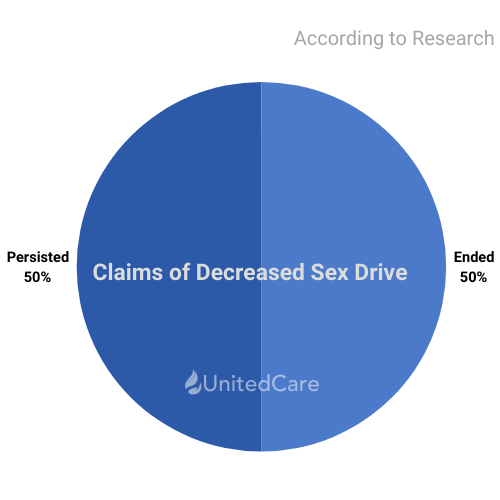
🔵 and patients who suffered from the nocebo effect had a rate of 59%.
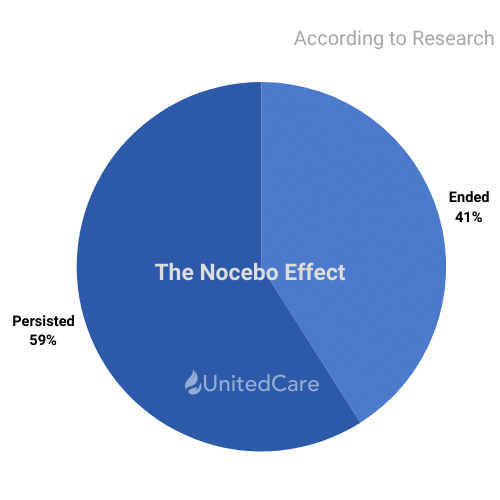
💡 Furthermore, the study points out that the rest of the group had stopped experiencing the side effect with the help of positive placebo therapy, further proving that the side effect mostly is caused by an external source.
Overall, this side effect is not a myth. Still, it’s scarce and usually triggered due to heavy stress, which is why it is always best to consult your doctor to learn that the side effects of Finasteride are rare. There is nothing to worry about as long as you are under your doctor’s supervision.
2- Ejaculation Disorder
This is another commonly feared side effect, and it is a completely real one, not a myth.
Yet, recent studies show that the rate of how common it is may be exaggerated due to the nocebo effect or simply patients experiencing personal stress after the impact of the treatment has already passed and perceiving that as a side effect.
🔹One study made on 3177 patients with 1 mg of daily doses over three years shows that ejaculation disorder appeared in only 23 (0.7%) patients.
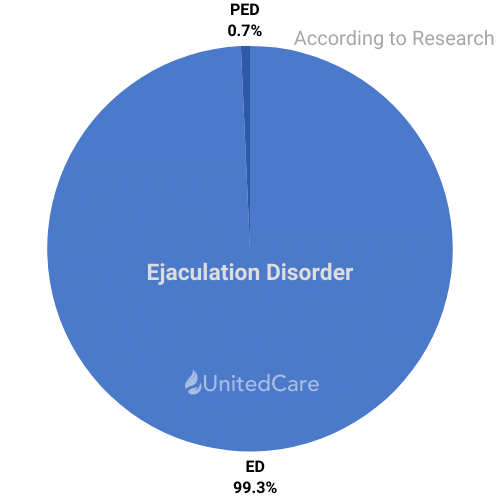
🔹 Furthermore, another research conducted for five years has also concluded different vital results on how this side effect occurs:
*️⃣ Ejaculation disorder most commonly occurs in year 1 of treatment with Finasteride, and later on, the signs of the side effects start to drop (from 4.4% in the first year to 0.7 at the end of the research period).
*️⃣ This further supports the existence of a nocebo effect as patients start to trust Finasteride more over time after they start seeing the results of how it regrows their hair and prevents further balding.
3- Erectile Dysfunction
This side effect is genuine, and probably out of all the side effects of Finasteride, the one that is the least rare. But unlike other side effects that showed signs of an external factor that supported their appearance rates, erectile dysfunction is not usually connected to the nocebo effect or a secondary disease.
Instead, studies show that erectile dysfunction is a natural and common side effect with a high probability because patients often view an utterly natural situation as a side effect. In other words, issues regarding self-reports are present.
The study that proves this result was made after a previous study regarding the rate of erectile dysfunctions.
➡️ The first study was an observational evaluation made in 2016 on 79 patients, and all of them were patients who had used Finasteride for over two years with a 1 mg dose. In this study, 40.5% of patients declared that getting and keeping an erection has gotten more difficult since they started using Finasteride.
➡️ However, a more modern, recent, and better-adjusted 2019 study from the ISHRS with a broader range of 762 patients made an addition to the previous research: Including patients who have never used Finasteride before. At the end of the study, a survey was given, asking whether they had experienced any instances of erectile dysfunction without referring to Finasteride.
💡 Surprisingly, dermatologists who were present in this research found that the answer rate for both groups was almost identical. They were very much the same.
In conclusion, as there was no significant difference between the rates of both groups, the connection of Finasteride to erectile dysfunction was found to be nonexistent. Or at least very low since patients would often experience this situation (regardless of using the medication) but would blame it on Finasteride.
4- Shrinkage
This is an apparent myth about Finasteride that commonly appears on hair loss forums.
There are no nocebo-controlled, objective studies that support its existence, and the claims are entirely based on patients’ personal experiences. That is why there also aren’t any studies showing that this side effect does not occur since there is no need for them.
5- Cancer
This is also another myth. Finasteride in no way causes cancer. Instead, studies have found that long-term use of Finasteride may reduce the chances of (prostate) cancer ever appearing.
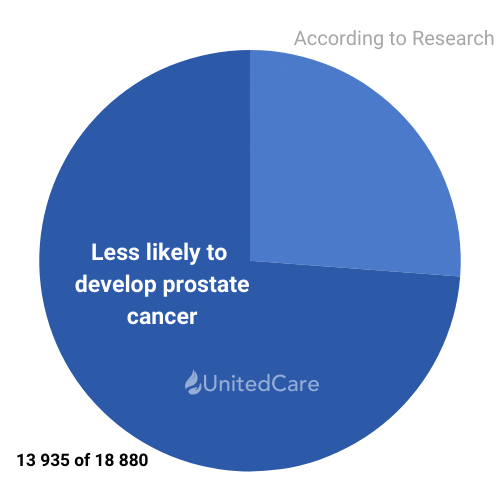
A seven-year study has deduced that 13 935 of 18 880 men who took Finasteride continuously were less likely to develop prostate cancer.
6- Reduction in Sperm Number
Lastly, this is our final side effect, which is also not a myth. Just like other side effects, studies made to determine its rate have discovered that reduction in sperm number (that can go back up after a patient stops using Finasteride) is also connected to an external factor: Secondary diseases. 👈
🔹 A study was conducted in 2013 with 4400 patients on Finasteride. In this study, researchers made different discoveries in different periods. During the initial results, researchers concluded that:
“No man had a decrease in sperm count.”
Furthermore, no other aspect of the sperm was changed, such as their effectiveness, hormone parameters, mobility, or morphology.
However, further research has discovered an interesting population of patients with an increased number of sperms after leaving the treatment of Finasteride: Patients who were already suffering from low numbers of sperms due to an existing disease, oligospermia.
Only out of this group, 50% of the population showed an increase after they stopped using Finasteride, which directly proves that there are no effects Finasteride could have on sperm numbers. Because even with this group combined, the entire population of patients didn’t show any decrease in sperm count.
The rest of the patients who did not have a secondary disease before starting Finasteride showed NO signs of an increase in sperm numbers after they stopped using it.
💡 As a result, researchers have concluded that a reduction in sperm number is possible at a low rate if Finasteride is approached without caution. That is why, once again, it is always best to consult your doctor about using it and your conditions that may trigger a side effect (which Finasteride would not cause alone).
In conclusion, the side effects of Finasteride are rare. Even if they appear, it is due to an external factor such as the nocebo effect or a secondary disease. Yet, they still hold a possibility of containing persisting sexual effects.
So, the question is: are they reversible?
Are Side Effects of Finasteride Reversible?
🔹 Yes. As research shows, the side effects of Finasteride are mild, rare, and completely reversible.
How you consume Finasteride supports this purpose as it is not a one-time treatment like an injection but a daily dose of pills. So, if you simply stop using Finasteride, you can completely reverse its side effects.
“How long does it take for the side effects to vanish?“
Finasteride’s side effects are not permanent and will not last forever. But depending on your body, the time it takes for specific side effects to vanish completely can feel like forever.
🟢 According to research, it takes patients at least three months on average to completely get rid of any persisting side effects. But this number can increase based on your body’s reactions and how much stress or shock loss the treatment creates.
So, if the effects persist for too long, you should reach out to your doctor immediately. It is best to consult with a professional dermatologist about every aspect of your body that can affect the treatment outcome.
Remember, numerous studies show us that patients must be educated if they wish to reduce the chances of risks, side effects, and a possible nocebo effect.
And that is exactly what we aim to do:
Finasteride Combined With Hair Transplants: Your Ticket to 10 Years Ago
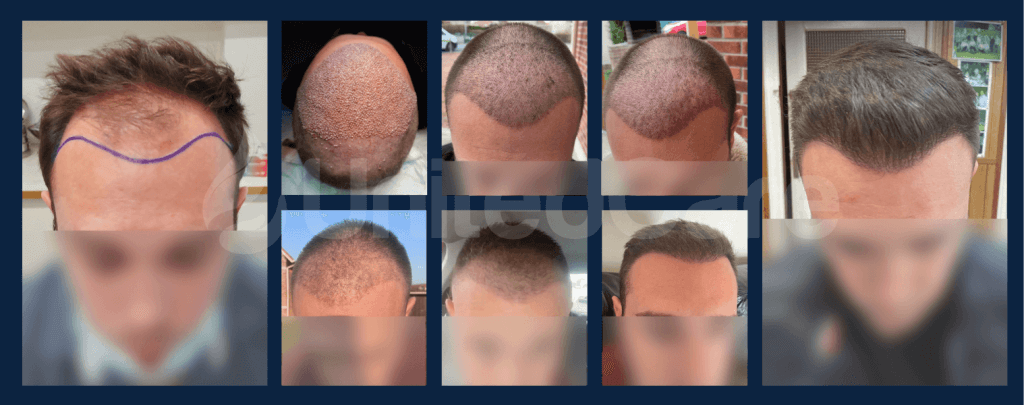
At UnitedCare, we begin your hair transplant process by offering you a free one-on-one consultation with our expert doctors to determine your suitability.
💊 If so, our holistic approach provides advanced technologies and bio-enhancements to ensure you do not need another surgery.
Once you have decided on a method, we begin the treatment with the utmost attention. 💉
But most importantly, we stay in contact with our patients even long after the surgery, ensuring that your transplant becomes permanent. 🍀
Affordable hair transplant costs, a holistic approach, and experienced dermatologists on-site are here to provide you with the right solution.
Want to learn more? Click here to reach out for a FREE consultation:
Ensuring success without worrying about any side effects is possible.
Restore your natural look with UnitedCare’s expert dermatologists while avoiding any risks:
Frequently Asked Questions (FAQs)
Does Finasteride cause erectile dysfunction?
Not necessarily. Although there are studies indicating that erectile dysfunction does appear in patients who use Finasteride, the latest studies show that these instances occur naturally, not strictly because of the treatment. As patients experience erectile dysfunction due to the high stress that a hair transplant or starting a new drug can create, they fall to the conclusion that the medication directly causes this effect. Instead, studies are showing that the rate of erectile dysfunction in patients who use Finasteride is the same as the population of patients who have never used Finasteride before. Thus, Finasteride does not directly cause it.
How common is erectile dysfunction with Finasteride?
According to an observational evaluation study made in 2016 on 79 patients, 40.5% of patients who had used Finasteride for more than two years with a 1 mg daily oral dose declared that getting and keeping an erection have gotten harder since they started using it. However, new research indicates that erectile dysfunction caused by Finasteride is only as common as ordinary-rate erectile dysfunction in men. As the group of patients who had never used Finasteride had the same rate as the group that had used Finasteride, the study concludes that Finasteride is not associated with this sexual dysfunction.
Does Finasteride cause shrinkage?
Finasteride does not cause shrinkage in any way. Its purpose is to affect and reduce the harmful hormone dihydrotestosterone (DHT) that causes baldness and benign prostatic hyperplasia (BPH) due to its excessive amount. This commonly mentioned “side effect” is but a mere popular myth that appears a lot in hair loss forums, as there are no studies indicating this adverse reaction.

